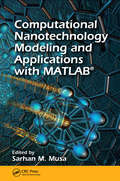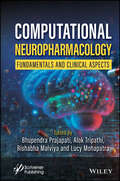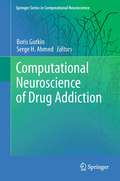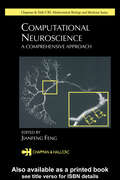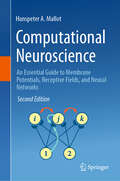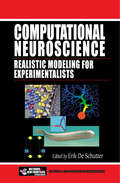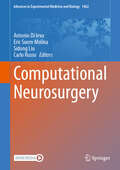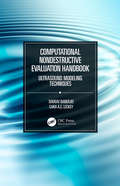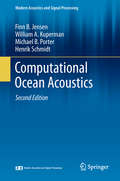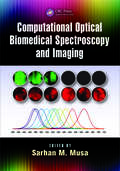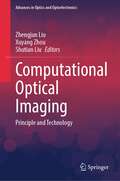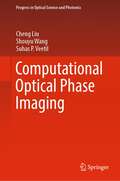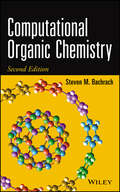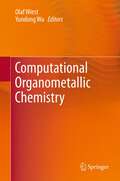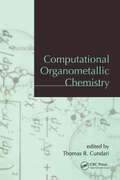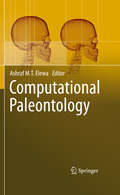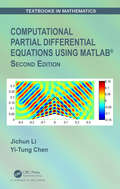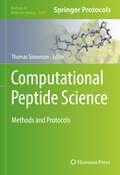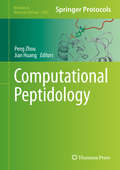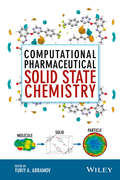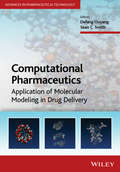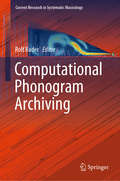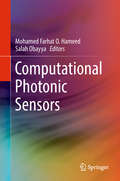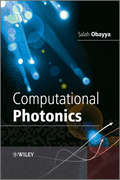- Table View
- List View
Computational Nanotechnology: Modeling and Applications with MATLAB® (Nano and Energy)
by Sarhan M. MusaApplications of nanotechnology continue to fuel significant innovations in areas ranging from electronics, microcomputing, and biotechnology to medicine, consumer supplies, aerospace, and energy production. As progress in nanoscale science and engineering leads to the continued development of advanced materials and new devices, improved methods of modeling and simulation are required to achieve a more robust quantitative understanding of matter at the nanoscale. Computational Nanotechnology: Modeling and Applications with MATLAB® provides expert insights into current and emerging methods, opportunities, and challenges associated with the computational techniques involved in nanoscale research. Written by, and for, those working in the interdisciplinary fields that comprise nanotechnology—including engineering, physics, chemistry, biology, and medicine—this book covers a broad spectrum of technical information, research ideas, and practical knowledge. It presents an introduction to computational methods in nanotechnology, including a closer look at the theory and modeling of two important nanoscale systems: molecular magnets and semiconductor quantum dots. Topics covered include: Modeling of nanoparticles and complex nano and MEMS systems Theory associated with micromagnetics Surface modeling of thin films Computational techniques used to validate hypotheses that may not be accessible through traditional experimentation Simulation methods for various nanotubes and modeling of carbon nanotube and silicon nanowire transistors In regard to applications of computational nanotechnology in biology, contributors describe tracking of nanoscale structures in cells, effects of various forces on cellular behavior, and use of protein-coated gold nanoparticles to better understand protein-associated nanomaterials. Emphasizing the importance of MATLAB for biological simulations in nanomedicine, this wide-ranging survey of computational nanotechnology concludes by discussing future directions in the field, highlighting the importance of the algorithms, modeling software, and computational tools in the development of efficient nanoscale systems.
Computational Neuropharmacology: Fundamentals and Clinical Aspects
by Rishabha Malviya Bhupendra Prajapati Alok Tripathi Lucy MohapatraThe book gives comprehensive insights into the cutting-edge intersection of computational methods and neuropharmacology, making it an essential resource for understanding and advancing medication for neurological and psychiatric disorders. Computational Neuropharmacology is an in-depth exploration of the convergence of computational methods with neuropharmacology, a science concerned with understanding pharmacological effects on the nervous system. This volume explores the most recent breakthroughs and potential advances in computational neuropharmacology, providing an extensive overview of the computational tools that are transforming medication discovery and development for neurological and psychiatric illnesses. Fundamental principles of computational neuropharmacology, descriptions of molecular-level interactions and their consequences for modern neuropharmacology, and an introduction to theoretical neuroscience are highlighted throughout this resource. Additionally, this study addresses computational attitudes in counseling psychology to improve therapeutic procedures through data-driven insights. Computational psychiatry uses computational technologies to bridge the gap between the molecular basis and clinical symptoms of psychiatric diseases. This volume covers computational approaches to drug discovery in neurohumoral transmission and signal transduction, Parkinson’s disease, epilepsy, and Alzheimer’s disease, and the use of molecular docking and machine learning in drug development for neurological disorders. It also discusses the use of computational methods to uncover potential treatments for autism spectrum disorder, depression, and anxiety. Audience This book is a valuable resource for computer scientists, engineers, researchers, clinicians, and students, providing a detailed understanding of the computational tools that are changing the developing field of neuropharmacology, leading the future of medication discovery and development for neurological and psychiatric illnesses by combining modern computational approaches with neuropharmacological research.
Computational Neuroscience of Drug Addiction (Springer Series in Computational Neuroscience #10)
by Serge H. Ahmed Boris GutkinDrug addiction remains one of the most important public health problems in western societies and is a rising concern for developing nations. Over the past 3 decades, experimental research on the neurobiology and psychology of drug addiction has generated a torrent of exciting data, from the molecular up to the behavioral levels. As a result, a new and pressing challenge for addiction research is to formulate a synthetic theoretical framework that goes well beyond mere scientific eclectism to deepen our understanding of drug addiction and to foster our capacity to prevent and to cure drug addiction. Intrigued by the apparent irrational behavior of drug addicts, researchers from a wide range of scientific disciplines have formulated a plethora of theoretical schemes over the years to understand addiction. However, most of these theories and models are qualitative in nature and are formulated using terms that are often ill-defined. As a result, the empirical validity of these models has been difficult to test rigorously, which has served to generate more controversy than clarity. In this context, as in other scientific fields, mathematical and computational modeling should contribute to the development of more testable and rigorous models of addiction.
Computational Neuroscience: A Comprehensive Approach (Chapman & Hall/CRC Computational Biology Series)
by Jianfeng FengHow does the brain work? After a century of research, we still lack a coherent view of how neurons process signals and control our activities. But as the field of computational neuroscience continues to evolve, we find that it provides a theoretical foundation and a set of technological approaches that can significantly enhance our understanding.
Computational Neuroscience: An Essential Guide to Membrane Potentials, Receptive Fields, and Neural Networks
by Hanspeter A. MallotThis book provides an essential introduction to modeling the nervous system at various levels. Readers will learn about the intricate mechanisms of neural activity, receptive fields, neural networks, and information coding. The chapters cover topics such as membrane potentials, the Hodgkin-Huxley theory, receptive fields and their specificity for important stimulus dimensions, Fourier analysis for neuroscientists, pattern recognition and self-organization in neural networks, and the structure of neural representations. The second edition includes revised text and figures for improved readability and completeness. Key points are highlighted throughout to help readers keep track of central ideas. Researchers in the field of neuroscience with backgrounds in biology, psychology, or medicine will find this book particularly beneficial. It is also an invaluable reference for all neuroscientists who use computational methods in their daily work. Whether you are a theoretical scientist approaching the field or an experienced practitioner seeking to deepen your understanding, "Computational Neuroscience - An Essential Guide to Membrane Potentials, Receptive Fields, and Neural Networks" offers a comprehensive guide to mastering the fundamentals of this dynamic discipline.
Computational Neuroscience: Realistic Modeling for Experimentalists (Frontiers in Neuroscience)
by Erik De Schutter Robert C. CannonDesigned primarily as an introduction to realistic modeling methods, Computational Neuroscience: Realistic Modeling for Experimentalists focuses on methodological approaches, selecting appropriate methods, and identifying potential pitfalls. The author addresses varying levels of complexity, from molecular interactions within single neurons to the processing of information by neural networks. He avoids theoretical mathematics and provides just enough of the basic math used by experimentalists. What makes this resource unique is the inclusion of downloadable resources that furnish interactive modeling examples. It contains tutorials and demos, movies and images, and the simulation scripts necessary to run the full simulation described in the chapter examples. Each chapter covers: the theoretical foundation; parameters needed; appropriate software descriptions; evaluation of the model; future directions expected; examples in text boxes linked to the downloadable resources; and references. The first book to bring you cutting-edge developments in neuronal modeling. It provides an introduction to realistic modeling methods at levels of complexity varying from molecular interactions to neural networks. The book and downloadable resources combine to make Computational Neuroscience: Realistic Modeling for Experimentalists the complete package for understanding modeling techniques.
Computational Neurosurgery (Advances in Experimental Medicine and Biology #1462)
by Carlo Russo Antonio Di Ieva Sidong Liu Eric Suero MolinaThis comprehensive and authoritative reference presents the state-of-the-art computational methods applied to the field of neurosurgery. The book brings together leading neuroscientists, neurosurgeons, mathematicians, computer scientists, engineers, ethicists and lawyers, to open the new frontier of computational neurosurgery to a broad audience interested in the translational field of the application of computational models, such as deep learning, to the study of the brain and the practical applications of neurosurgery. The focus is primarily clinical, and there is a solid foundation of research aspects. With forewords by Michael L.J. Apuzzo and Enrico Coiera, the book is organized into 2 sections: (1) tenets of computational modeling, artificial intelligence, computational analysis, and analysis software; (2) computational neurosurgery applications, including neurodiagnostics, neuro-oncology, vascular neurosurgery, all the neurosurgical disciplines, surgical approaches, intraoperative applications, and ethics and legal aspects.
Computational Nondestructive Evaluation Handbook: Ultrasound Modeling Techniques
by Sourav Banerjee Cara A.C. LeckeyIntroducing computational wave propagation methods developed over 40 years of research, this comprehensive book offers a computational approach to NDE of isotropic, anisotropic, and functionally graded materials. It discusses recent methods to enable enhanced computational efficiency for anisotropic materials. It offers an overview of the need for and uses of NDE simulation. The content provides a basic understanding of ultrasonic wave propagation through continuum mechanics and detailed discussions on the mathematical techniques of six computational methods to simulate NDE experiments. In this book, the pros and cons of each individual method are discussed and guidelines for selecting specific simulation methods for specific NDE scenarios are offered. Covers ultrasonic CNDE fundamentals to provide understanding of NDE simulation methods Offers a catalog of effective CNDE methods to evaluate and compare Provides exercises on real-life NDE problems with mathematical steps Discusses CNDE for common material types, including isotropic, anisotropic, and functionally graded materials Presents readers with practical knowledge on ultrasonic CNDE methods This work is an invaluable resource for researchers, advanced students, and industry professionals across materials, mechanical, civil, and aerospace engineering, and anyone seeking to enhance their understanding of computational approaches for advanced material evaluation methods.
Computational Ocean Acoustics (Modern Acoustics and Signal Processing)
by Henrik Schmidt Michael B. Porter Finn B. Jensen William A. KupermanSenior level/graduate level text/reference presenting state-of-the- art numerical techniques to solve the wave equation in heterogeneous fluid-solid media. Numerical models have become standard research tools in acoustic laboratories, and thus computational acoustics is becoming an increasingly important branch of ocean acoustic science. The first edition of this successful book, written by the recognized leaders of the field, was the first to present a comprehensive and modern introduction to computational ocean acoustics accessible to students. This revision, with 100 additional pages, completely updates the material in the first edition and includes new models based on current research. It includes problems and solutions in every chapter, making the book more useful in teaching (the first edition had a separate solutions manual). The book is intended for graduate and advanced undergraduate students of acoustics, geology and geophysics, applied mathematics, ocean engineering or as a reference in computational methods courses, as well as professionals in these fields, particularly those working in government (especially Navy) and industry labs engaged in the development or use of propagating models.
Computational Optical Biomedical Spectroscopy and Imaging
by Sarhan M. MusaComputational Optical Biomedical Spectroscopy and Imaging covers recent discoveries and research in the field by some of the best inventors and researchers in the world. It also presents useful computational methods and applications used in optical biomedical spectroscopy and imaging. Topics covered include:New trends in immunohistochemical, genome
Computational Optical Imaging: Principle and Technology (Advances in Optics and Optoelectronics)
by Zhengjun Liu Xuyang Zhou Shutian LiuThis book highlights a comprehensive introduction to the principles and calculation methods of computational optical imaging. Integrating optical imaging and computing technology to achieve significant performance improvements, computational optical imaging has become an active research field in optics. It has given rise to the emerging of new concepts such as computational imaging, computational measurement and computational photography. As high-performance image detectors make image measurements discrete and digital, images are mostly recorded in the form of discrete data, almost replacing the continuous medium used for pattern recording. Computational optical imaging technology has become an effective way for people to study microscopic imaging. At present, different imaging systems are composed of continuous optical elements such as lenses and prisms or discrete optical elements such as spatial light modulators or digital micro-mirror devices. The current computing technology has permeated all aspects of imaging systems and gradually promotes the digitization of optical imaging systems. This book summarizes the representative work done in this field and introduces the latest results. Computing technology plays an important bridging role between theories of optics and experimental systems, which inspires more comprehensive and in-depth research. It has the advantages of high repeatability, flexibility, strong computing power and low cost. In this multidisciplinary field, researchers in computer science, optics and information science have joined together to extend its depth and breadth. Targeting cutting-edge issues to be solved in computational optics, this book introduces a variety of methods that involve theoretical innovations and technical breakthroughs in imaging resolution, the field of view, imaging speed, and computing speed. It intends to provide a handy reference and technical support for graduate students, researchers and professionals engaged in the study and practice of computational optical imaging.
Computational Optical Phase Imaging (Progress in Optical Science and Photonics #21)
by Cheng Liu Shouyu Wang Suhas P. VeetilIn this book, computational optical phase imaging techniques are presented along with Matlab codes that allow the reader to run their own simulations and gain a thorough understanding of the current state-of-the-art. The book focuses on modern applications of computational optical phase imaging in engineering measurements and biomedical imaging. Additionally, it discusses the future of computational optical phase imaging, especially in terms of system miniaturization and deep learning-based phase retrieval.
Computational Organic Chemistry
by Steven M. BachrachThe Second Edition demonstrates how computational chemistry continues to shed new light on organic chemistryThe Second Edition of author Steven Bachrach's highly acclaimed Computational Organic Chemistry reflects the tremendous advances in computational methods since the publication of the First Edition, explaining how these advances have shaped our current understanding of organic chemistry. Readers familiar with the First Edition will discover new and revised material in all chapters, including new case studies and examples. There's also a new chapter dedicated to computational enzymology that demonstrates how principles of quantum mechanics applied to organic reactions can be extended to biological systems.Computational Organic Chemistry covers a broad range of problems and challenges in organic chemistry where computational chemistry has played a significant role in developing new theories or where it has provided additional evidence to support experimentally derived insights. Readers do not have to be experts in quantum mechanics. The first chapter of the book introduces all of the major theoretical concepts and definitions of quantum mechanics followed by a chapter dedicated to computed spectral properties and structure identification. Next, the book covers:Fundamentals of organic chemistryPericyclic reactionsDiradicals and carbenesOrganic reactions of anionsSolution-phase organic chemistryOrganic reaction dynamicsThe final chapter offers new computational approaches to understand enzymes. The book features interviews with preeminent computational chemists, underscoring the role of collaboration in developing new science. Three of these interviews are new to this edition.Readers interested in exploring individual topics in greater depth should turn to the book's ancillary website www.comporgchem.com, which offers updates and supporting information. Plus, every cited article that is available in electronic form is listed with a link to the article.
Computational Organometallic Chemistry
by Olaf Wiest Yundong WuComputational methods have become an indispensible tool for elucidating the mechanism of organometallic reactions. This snapshot of state-of-the-art computational studies provides an overview of the vast field of computational organometallic chemistry. Authors from Asia, Europe and the US have been selected to contribute a chapter on their specialist areas. Topics addressed include: DFT studies on zirconium-mediated reactions, force field methods in organometallic chemistry, hydrogenation of π-systems, oxidative functionalization of unactivated C-H bonds and olefins, the osmylation reaction, and cobalt carbonyl clusters. The breadth and depth of the contributions demonstrate not only the crucial role that computational methods play in the study of a wide range of organometallic reactions, but also attest the robust health of the field, which continues to benefit from, as well as inspire novel experimental studies.
Computational Organometallic Chemistry
by Thomas R. CundariThis work provides a how-to approach to the fundamentals, methodologies and dynamics of computational organometallic chemistry, including classical and molecular mechanics (MM), quantum mechanics (QM), and hybrid MM/QM techniques. It demonstrates applications in actinide chemistry, catalysis, main group chemistry, medicine, and organic synthesis.
Computational Paleontology
by Ashraf M.T. ElewaComputational paleontology is simply a term applied to using computers and its facilities in the field of paleontology. However, we should be exactly precise in describing the term through explaining the main themes of this motivating and attractive scientific field. The uppermost aim of this book is to explain how computation could be competent in fetching fossils to life and the past to present. Computers for paleontologists save time and costs, interpret mysterious events precisely and accurately, visualize the ancient life definitely and undeniably.
Computational Partial Differential Equations Using MATLAB® (Textbooks in Mathematics)
by Jichun Li Yi-Tung ChenIn this popular text for an Numerical Analysis course, the authors introduce several major methods of solving various partial differential equations (PDEs) including elliptic, parabolic, and hyperbolic equations. It covers traditional techniques including the classic finite difference method, finite element method, and state-of-the-art numercial methods.The text uniquely emphasizes both theoretical numerical analysis and practical implementation of the algorithms in MATLAB. This new edition includes a new chapter, Finite Value Method, the presentation has been tightened, new exercises and applications are included, and the text refers now to the latest release of MATLAB. Key Selling Points: A successful textbook for an undergraduate text on numerical analysis or methods taught in mathematics and computer engineering. This course is taught in every university throughout the world with an engineering department or school. Competitive advantage broader numerical methods (including finite difference, finite element, meshless method, and finite volume method), provides the MATLAB source code for most popular PDEs with detailed explanation about the implementation and theoretical analysis. No other existing textbook in the market offers a good combination of theoretical depth and practical source codes.
Computational Peptide Science: Methods and Protocols (Methods in Molecular Biology #2405)
by Thomas SimonsonThis volume details current and new computational methodologies to study peptides. Chapters guide readers through antimicrobial peptides, foldability, amyloid sheet formation, membrane-active peptides, organized peptide assemblies, protein-peptide interfaces, prediction of peptide-MHC complexes, advanced free energy simulations for peptide binding, and methods for high throughput peptide or miniprotein design. Written in the format of the highly successful Methods in Molecular Biology series, each chapter includes an introduction to the topic, lists necessary materials, software, and reagents, includes tips on troubleshooting and known pitfalls, and step-by-step, readily reproducible protocols. Authoritative and cutting-edge, Computational Peptides Science: Methods and Protocols aims to provide concepts, methods, and guidelines to help both novices and experienced workers benefit from today's new opportunities and challenges.
Computational Peptidology (Methods in Molecular Biology #1268)
by Peng Zhou Jian HuangIn this volume expert researchers detail in silico methods widely used to study peptides. These include methods and techniques covering the database, molecular docking, dynamics simulation, data mining, de novo design and structure modeling of peptides and protein fragments. Chapters focus on integration and application of technologies to analyze, model, identify, predict, and design a wide variety of bioactive peptides, peptide analogues and peptide drugs, as well as peptide-based biomaterials. Written in the highly successful Methods in Molecular Biology series format, chapters include introductions to their respective topics, lists of the necessary materials and reagents, step-by-step, readily reproducible laboratory protocols, and key tips on troubleshooting and avoiding known pitfalls. Authoritative and practical, Computational Peptidology seeks to aid scientists in the further study into this newly rising subfield.
Computational Pharmaceutical Solid State Chemistry
by Yuriy A. AbramovRecent trends within the pharmaceutical industry through the Quality by Design initiatives have seen a greater emphasis on the development of a molecular-scale understanding in the development of efficient manufacturing processes for active pharmaceutical ingredients (APIs) and their formulation into drug products. This book examines the state-of-the-art computational approaches to guide solid form experiments to optimize the physical and chemical properties of API related to its stability, bioavailability and formulatability. The book is intended to be used as a professional reference to researchers in Pharmaceutical industry and in academia and potentially as a text book reference for undergraduate, graduate and postgraduate students in the field of Computational Chemistry, Solid State Chemistry, Pharmaceutical Science and Material Science.
Computational Pharmaceutics
by Juergen Siepmann Dennis Douroumis Alfred Fahr Defang Ouyang Sean C. Smith Vladimir Torchilin Martin J. SnowdenMolecular modeling techniques have been widely used in drug discovery fields for rational drug design and compound screening. Now these techniques are used to model or mimic the behavior of molecules, and help us study formulation at the molecular level. Computational pharmaceutics enables us to understand the mechanism of drug delivery, and to develop new drug delivery systems. The book discusses the modeling of different drug delivery systems, including cyclodextrins, solid dispersions, polymorphism prediction, dendrimer-based delivery systems, surfactant-based micelle, polymeric drug delivery systems, liposome, protein/peptide formulations, non-viral gene delivery systems, drug-protein binding, silica nanoparticles, carbon nanotube-based drug delivery systems, diamond nanoparticles and layered double hydroxides (LDHs) drug delivery systems. Although there are a number of existing books about rational drug design with molecular modeling techniques, these techniques still look mysterious and daunting for pharmaceutical scientists. This book fills the gap between pharmaceutics and molecular modeling, and presents a systematic and overall introduction to computational pharmaceutics. It covers all introductory, advanced and specialist levels. It provides a totally different perspective to pharmaceutical scientists, and will greatly facilitate the development of pharmaceutics. It also helps computational chemists to look for the important questions in the drug delivery field. This book is included in the Advances in Pharmaceutical Technology book series.
Computational Phonogram Archiving (Current Research in Systematic Musicology #5)
by Rolf BaderThe future of music archiving and search engines lies in deep learning and big data. Music information retrieval algorithms automatically analyze musical features like timbre, melody, rhythm or musical form, and artificial intelligence then sorts and relates these features. At the first International Symposium on Computational Ethnomusicological Archiving held on November 9 to 11, 2017 at the Institute of Systematic Musicology in Hamburg, Germany, a new Computational Phonogram Archiving standard was discussed as an interdisciplinary approach. Ethnomusicologists, music and computer scientists, systematic musicologists as well as music archivists, composers and musicians presented tools, methods and platforms and shared fieldwork and archiving experiences in the fields of musical acoustics, informatics, music theory as well as on music storage, reproduction and metadata. The Computational Phonogram Archiving standard is also in high demand in the music market as a search engine for music consumers. This book offers a comprehensive overview of the field written by leading researchers around the globe.
Computational Photonic Sensors
by Salah Obayya Mohamed Farhat HameedThis book provides a comprehensive overview of the photonic sensing field by covering plasmonics, photonic crystal, and SOI techniques from theory to real sensing applications. A literature review of ultra-sensitive photonic sensors, including their design and application in industry, makes this a self-contained and comprehensive resource for different types of sensors, with high value to the biosensor sector in particular. The book is organized into four parts: Part I covers the basic theory of wave propagation, basic principles of sensing, surface plasmon resonance, and silicon photonics; Part II details the computational modeling techniques for the analysis and prediction of photonic sensors; Part III and Part IV cover the various mechanisms and light matter interaction scenarios behind the design of photonic sensors including photonic crystal fiber sensors and SOI sensors. This book is appropriate for academics and researchers specializing in photonic sensors; graduate students in the early and intermediate stages working in the areas of photonics, sensors, biophysics, and biomedical engineering; and to biomedical, environmental, and chemical engineers.
Computational Photonics
by Salah ObayyaThis book explores the state-of-the art in computational modelling techniques for photonic devicesIn this book, the author provides a comprehensive coverage of modern numerical modelling techniques for designing photonic devices for use in modern optical telecommunications systems. In addition the book presents the state-of-the-art in computational photonics techniques, covering methods such as full-vectorial finite-element beam propagation, bidirectional beam propagation, complex-envelope alternative direction implicit finite difference time domain, multiresolution time domain, and finite volume time domain. The book guides the reader through the concepts of modelling, analysing, designing and optimising the performance of a wide range of photonic devices by building their own numerical code using these methods.Key Features:Provides a thorough presentation of the state-of-the art in computational modelling techniques for photonicsContains broad coverage of both frequency- and time-domain techniques to suit a wide range of photonic devicesReviews existing commercial software packages for photonicsPresents the advantages and disadvantages of the different modelling techniques as well as their suitability for various photonic devicesShows the reader how to model, analyse, design and optimise the performance of a wide range of photonic devices by building their own numerical code using these methodsAccompanying website contains the numerical examples representing the numerical techniques in this book, as well as several design examples (http://www.wiley.com/go/obayya_computational)This book will serve as an invaluable reference for researchers, optical telecommunications engineers, engineers in the photonics industry. PhD and MSc students undertaking courses in the areas of photonics and optical telecommunications will also find this book of interest.
